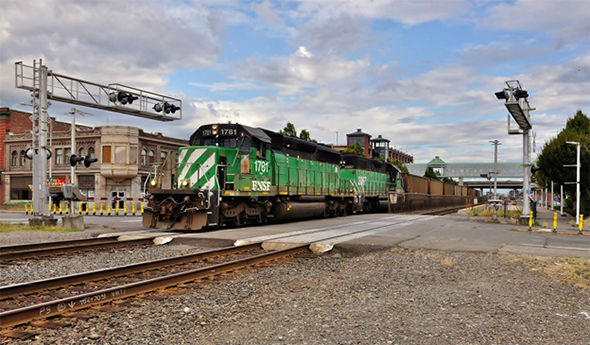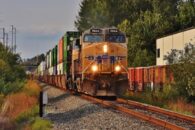
The FRA is holding a new grade crossing safety research workshop in August to help define new ways to improve the safety at such sites. Grade crossings remain a primary cause of rail-related accidents in North America. A BNSF coal train rolls over the Main Street crossing in Auburn, Washington in July of 2016. Image © 7/2016 by Nikki Burgess; all rights reserved.
The approach of mid-July finds summer getting in to full swing; remember to pay attention to managing heat related issues in your workplace, and remind everyone to watch out on the road—many more pedestrians, especially children, are “out and about” in the long dusk of the summer. Safety first! Here’s this week’s regulatory action:
PHMSA
In an action that may have ongoing consequences, the agency issued a finding of pre-emption in the case of an attempt by the City of New York to levy separate fees and require separate inspections of motor vehicles carrying hazardous materials in that municipality. This was at the behest of several associations related to motor carriers, who contended that the new program unfairly affected their ability to do business. PHMSA’s finding asserts that federal interstate commerce law has primacy over such matters and that local authorities cannot take action which may have the effect of restricting interstate commerce in any way that subverts federal control. A number of cities and states either have or are considering action similar to that which NYC took; these potential actions (and in the case of California, an actual tax on hazmat carrying rail cars) may well be impacted by this precedent. It will certainly be interesting to see what use is made of the finding by other entities facing such actions. See the details here
EPA
As required by the Toxic Substances Control Act (TSCA), which was amended by the Frank R. Lautenberg Chemical Safety for the 21st Century Act in June 2016, EPA is announcing the availability of the scope documents for the risk evaluations to be conducted for the first ten (10) chemical substances. Each scope includes the hazards, exposures, conditions of use, and the potentially exposed or susceptible subpopulations the EPA expects to consider in conducting the risk evaluation. EPA is also re-opening existing dockets for the first 10 chemicals to allow for the public to provide additional data or information that could be useful to the Agency in conducting problem formulation, the next step in the process of conducting the risk evaluations for these chemicals. The revision to the TSCA requires the agency to eventually revaluate the current listings on a more comprehensive basis. See the scope documents via this portal
OSHA
On November 18, 2016, OSHA published a final rule revising and updating the general industry Walking-Working Surfaces and Personal Protective Equipment (Fall Protection Systems) standards. This new action adds three collections of information (ICR’s) related to the following provisions of the rule:
- The first requires that employers ensure any ladder with structural or other defects be tagged immediately with ‘‘Dangerous: Do Not Use’’ or similar language and removed from service until ‘‘repaired . . . or replaced.’’ The information will alert employers and workers that the ladder is not safe and must not be used.
- Next, the rule requires, before any rope descent system is used, that the building owner inform the employer in writing that the building owner has identified, tested, certified, and maintained each anchorage so it is capable of supporting at least 5,000 pounds (268 kg), in any direction for each employee attached. The information must be based on an annual inspection by a qualified person and certification of each anchorage by a qualified person, as necessary, and at least every 10 years.
- Third, the rule specifies that when employers can demonstrate that it is not feasible or creates a greater hazard to use guardrail, safety net, or personal fall protection systems on residential roofs, they must develop and implement a written fall protection plan that meets the requirements of 29 CFR 1926.502(k) and training that meets the requirements of 29 CFR 1926.503(a) and (c).
The collections of information in final subpart D are necessary to ensure workers are protected from death or injury from falls from elevated heights. See the implementations of these ICR’s here
FMCSA
The nation’s motor carrier safety agency announced a renewal of an ICR that collects information on accidents and incidents. FMCSA uses this information to develop new action to increase road safety for its affected carriers. See the ICR here
On a related vehicle safety note, the Commercial Vehicle Safety Alliance, an industry association dedicated to improving the safety of operations of our nation’s motor carrier fleet, announced that 2017 “Brake Safety Day” will be on September 7th. Carriers can expect increased enforcement of brake standards during roadside stops and or checks on weight scales on that day. See the program details here
FRA
The rail safety agency announced a new grade crossing safety research workshop to be held in St. Louis, one of the nation’s busiest rail hubs, on August 15th. The workshop will bring together experts across the industry and its vendors to investigate ways to help improve the effectiveness of safety devices at grade crossings. Crossing accidents remain the primary cause of railroad related accidents and incidents in North America. See the workshop details here
Labelmaster is a full service provider of products and services for the Hazardous Materials and Dangerous Goods professional, shippers, transport operators, and EH&S providers. See our full line of solutions at www.labelmaster.com.



